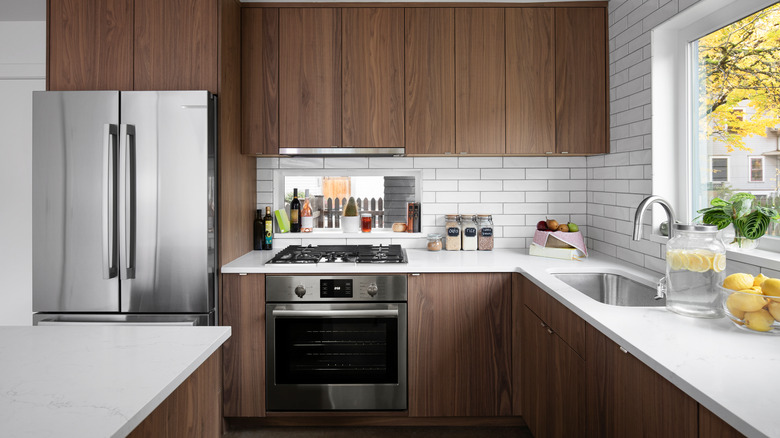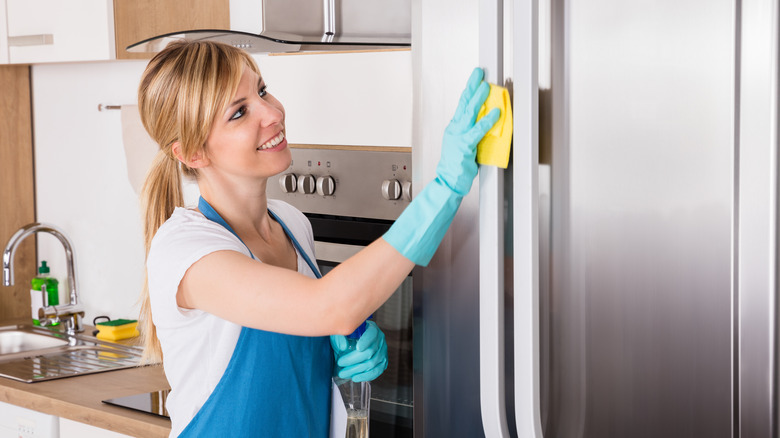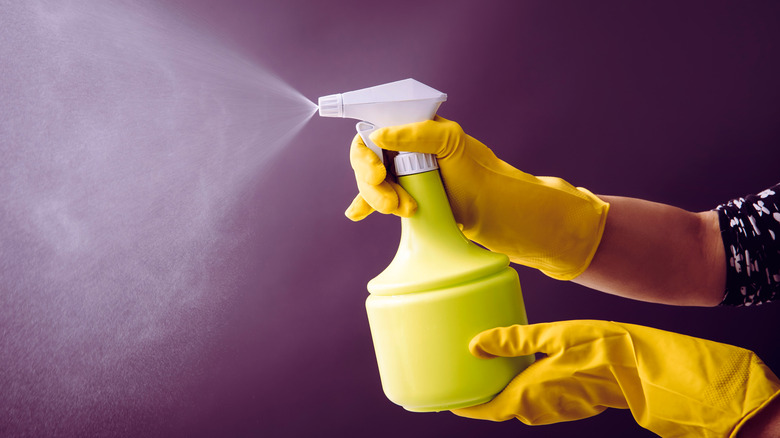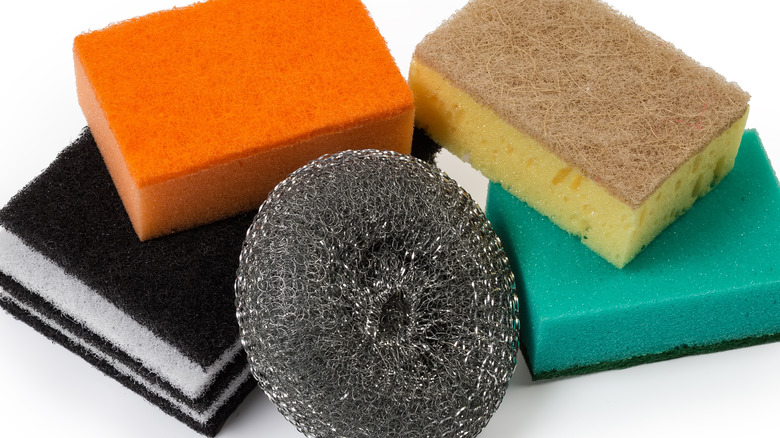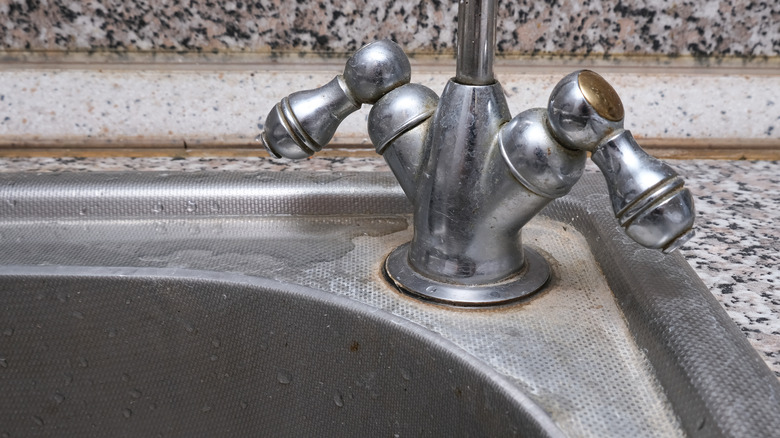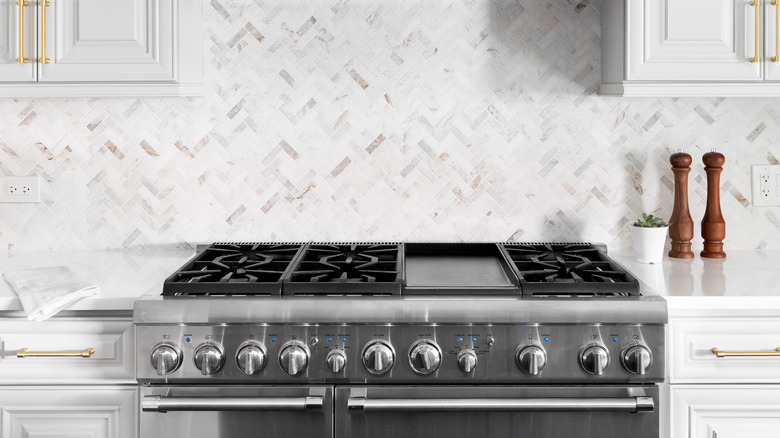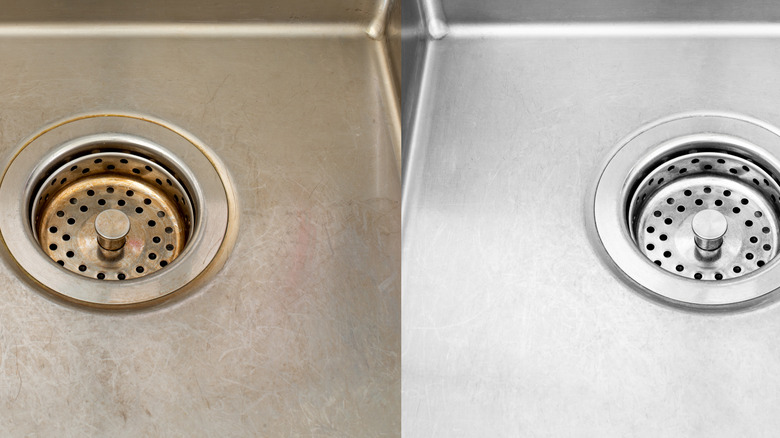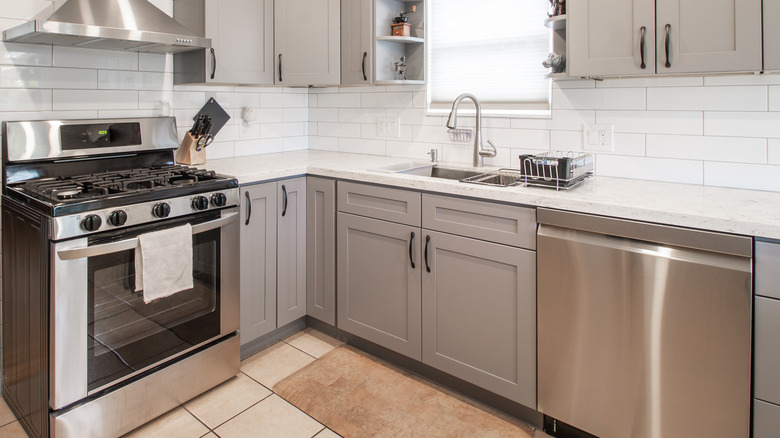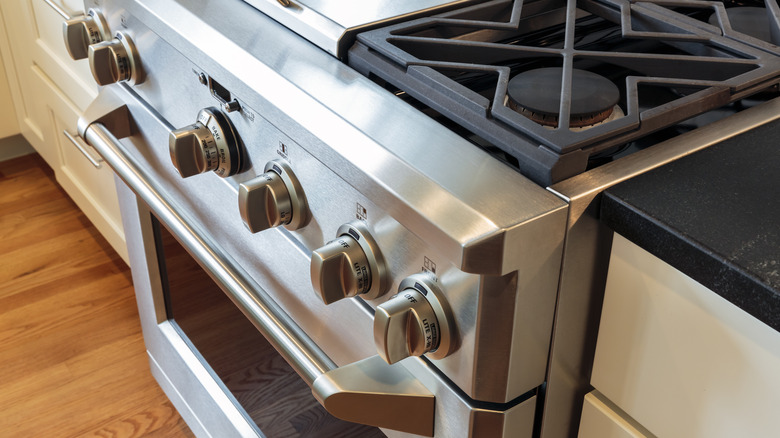Don't Make These Common Mistakes With Your Stainless Steel Appliances
Stainless steel appliances have been in style for over 20 years. The luxe look started out in commercial kitchens but has gained popularity in modern homes because the appliances look upscale and professional, are durable, and clean well, as per Architecture Restoration. The sleek style seems like it's here to stay. According to a kitchen trend survey from Houzz, nearly 70% of homeowners who upgraded appliances during a kitchen renovation chose stainless steel appliances, including 93% for refrigerators, 93% for dishwashers, 83% for microwaves, and 72% for range.
As Angi explains, the downside of stainless steel is that it's prone to showing smudges, fingerprints, and stains. But the good news is these infractions are easily cleaned. Still, you must be careful with how you clean stainless steel appliances because if you're not careful, you could scratch or damage them. Read on for tips on common mistakes to avoid with your stainless steel.
Don't use abrasive cleaners
Be careful when you're cleaning stainless steel appliances that you don't use any cleaners that are too harsh. As The Maids explains, the wrong cleaner can scratch the surface of your stainless steel. The best strategy in this cleaning situation is less is more. The easiest way to clean your stainless steel is by using a soft cloth, like a microfiber cloth, and wetting it with a bit of water. After washing the surface, make sure you completely dry it after cleaning.
You can wash stainless steel with mild dish soap as a cleanser too. The Maids has this DIY cleaning solution: add 1 teaspoon of dish soap to 1 quart of warm water, and then clean the surface with a microfiber towel. Use another damp microfiber towel to remove any excess soap. Next, add a drop or two of baby oil or mineral oil to a microfiber towel and gently rub it into the surface to bring out the shine.
Don't use bleach
Bleach is a powerful household cleaner that can disinfect surfaces. But when it comes to cleaning stainless steel appliances, bleach is something to avoid. Here's why: Chemicals in bleach can cause your stainless steel to stain. A chemical in stainless steel called chromium oxide protects that surface. But bleach can damage that protective layer and corrode it, resulting in stains that look brown or gray. If you have used bleach on your stainless steel appliances and they have discoloration, apply a thin layer of baking soda mixed with water, let it sit for a while, and then rub it until the stains go away.
As an alternative to cleaning stainless steel with bleach, consider club soda which does double duty to disinfect and add shine. You can use vinegar to clean your stainless steel as well. Inox Kitchen Design recommends using white vinegar and spraying it from a spray bottle so that you can clean in thin layers. Spray the area you want to clean, and then use a microfiber cloth to wipe the surface. Even though vinegar is an acid, it's weak and will not have a chemical reaction with the metal the same way bleach will.
Don't use abrasive cleaning tools
Before you clean stainless steel appliances, think about the tools you plan to use to clean them. While traditional kitchen appliances may be able to withstand harsh cleaning tools like scrubber pads or stiff-bristled brushes, stainless steel appliances need a gentler approach.
The Maids advises avoiding steel wool sponges and brushes that can scratch your stainless steel. Terry's Plumbing explains those scratches can ultimately lead to rust. Instead of abrasive tools, use nylon scrubbers that are tough enough to clean the surface without damaging it.
Not sure if your tool is too harsh? Do a small spot test in an inconspicuous area of the appliance. You can also read your owner's manual to see what's encouraged or prohibited. Some manufacturers apply a protective finish that can be dulled or ruined by certain cleaning products, and the manual will warn you of what to avoid.
Don't use hard water
You might think twice about buying stainless steel appliances if you have hard water. That's because stainless steel appliances are susceptible to water spots. If water spills on your appliances, like on your stovetop, wipe it immediately. As Dawn explains, it's wise to avoid air drying because water spots can stain and be hard to clean. If your stainless steel appliance has water spots, try cleaning them by spraying white vinegar onto the water stain and allowing it to sit for a few minutes before wiping it off with a soft cloth in the direction of the stainless steel grain.
You can also try applying rubbing alcohol to a soft cloth and gently scrubbing the water spot. Another DIY cleaning method is applying a thin layer of lemon juice for a few minutes, followed by sprinkling baking soda. The mixture will foam and can be cleaned with a soft cloth.
Don't wipe against the grain when cleaning
You've heard the phrase "don't go against the grain," which means doing something different from usual. That concept is true about cleaning stainless steel too, because you want to go with the normal, natural flow of your stainless steel.
The grain in stainless steel will vary from item to item. That's because it depends on the science of how the atoms in the metal align in a crystal structure (via Ulbrich). Angi says you'll get the best cleaning results by going with the grain, not across it. That means you'll be able to avoid streaks. KitchenAid says you can find the grain by looking at your appliance and seeing which way the lines go on the surface, such as vertically or horizontally. If the grain is vertical, clean from top to bottom. And if it's horizontal, clean from left to right. If your appliance has stuck-on food or other debris, gently clean the area in the direction of the grain.
Don't let it get rusty
You might not expect your stainless steel appliance to get rusty, but it can happen. According to GE Appliance, rust can occur when the stainless steel's protective layer of chromium oxide is damaged. That protective layer is typically ruined by harsh cleaners like those with chlorine, ammonia, or alcohol.
The good news is that the rust can be removed relatively easily. Make a paste with baking soda and water and apply the paste to the area with rust. You can also use the liquid Bar Keepers Friend, which doesn't have a gritty texture that could scratch your surface. Use a cloth or soft-bristled brush and wipe that paste in the direction of the grain. Keep working at removing the rust until it is gone. Then rinse and dry completely with a soft cloth.
For an unconventional cleaner, Scrubbi recommends using ketchup to remove the rust, explaining the acetic acid in the condiment will get the job done. All you have to do is apply ketchup in a layer on the rust for 30 minutes. Then gently scrub, rinse, and dry.
Don't have streaks
If you ever wipe down your stainless steel appliances like a stove, dishwasher, microwave, or refrigerator, and noticed streaks, you're not alone. You've already cleaned the appliance, so what's the problem? Often, it's due to hard water stains, as explained earlier. Or your cleaning solution could have dripped, and not been rinsed, and dried properly too.
Proline Range Hoods has five suggestions for cleaning your stainless steel to make it streak-free. The first option is using lemon oil polish which you can apply to a cloth and then wipe with the grain. Next is mineral oil or baby oil on a soft cloth. Other options are to use a commercial stainless steel cleaner; vinegar on a damp microfiber cloth; or a glass cleaner.
Beach Life Bliss agrees and says baby oil is her secret weapon to removing streaks from her stainless steel appliances. She recommends applying the baby oil to a cloth and wiping your appliances for a minute and allowing the oil to dry. If streaks linger, apply more baby oil to the cloth, and add a little pressure when wiping.
Don't have fingerprints
It's easy to get fingerprints all over your stainless steel appliances, especially your refrigerator. Just think about all the times you open the fridge or freezer door to get a drink, grab a snack, or put something away while cooking. And while it seems like stainless steel shouldn't show any of these spots because its name implies it's impervious to stains, this appliance style is notorious for showing fingerprints.
The Happier Homemaker, the mother of three boys, knows the frustration of fingerprints on her stainless steel appliances. But she has a solution. First, she cleans the prints with a window cleaner (or vinegar if the stains are tough) and then tries to prevent future fingerprints by applying Turtle Wax which she buffs in with a microfiber cloth. She repeats the routine every few weeks. Another consumer, TikTok user Kara.Shops.It.All, says she sprays wood cleaner Method Wood for Good Daily Clean on her refrigerator to wipe away fingerprints.
Don't let it get dull
If your stainless steel looks dull, there are a few ways to bring back its luster. Angi says using olive oil on a microfiber cloth can bring stainless steel surfaces, such as sinks, back to life. First, clean the appliance, apply the cloth with oil, and buff it to shine.
Sears Home Services has some other helpful tips to make your stainless steel appliances shine. On a dry sink, use flour to buff your kitchen sink. But be careful because if the flour gets wet, it'll be a mess. A similar solution, baking soda with water, can make your sink spotless without the mess. If you don't have any vinegar for cleaning, substitute club soda which can both clean your appliances and help them sparkle.
There are two big takeaways to keep your stainless steel looking good: Make sure you use a microfiber towel not to create any noticeable scratches, and dry surfaces well to prevent future streaks and stains.
